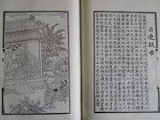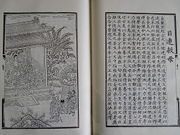
Maudgalyayana
Encyclopedia
Maudgalyāyana , also known as Mahāmaudgalyāyana or Mahāmoggallāna, was one of the Śākyamuni Buddha
's closest disciples. A contemporary of famous arhats such as Subhūti
, Śāriputra
, and Mahākāśyapa
, he is considered the second of the Buddha's two foremost disciples (foremost in supernatural powers), together with Śāriputra. He was born in a Brahmin
family of Kolita.
Maudgalyāyana was the most accomplished of all the Buddha's disciples in the various supernormal powers that could be developed through meditation. These abilities included being able to use mind-reading for such things as detecting lies from truths, transporting himself from his body into the various realms of existence, and speaking with ghosts and gods. He is traditionally attributed with the ability to do such things as walking through walls, walking on water, flying through the air, and moving with a speed comparable to the speed of light.
Varying accounts in the Pali Canon
show Maudgalyāyana speaking with the deceased in order to explain to them their horrific conditions and give them an understanding of their own suffering, so that they may be released from it or come to terms with it. Maudgalyāyana was able to use his powers of mind-reading in order to give good and fitting advice to his students, so they could attain results quickly.
. Some accounts put forth that religious cultists stoned him to death, others say it was robbers. The general consensus is that he was killed in a brutal fashion. When asked why Maudgalyāyana had not protected himself, and why a great arhat would suffer such a death, the Buddha said that because Maudgalyāyana had contracted such karma in a previous life (he had murdered his parents in a previous life—one of the five cardinal sins of Buddhism), so he had no escape from reaping the consequences and had accepted the results. Further, the Buddha stated that even supernormal powers will be of little or no use to oneself in avoiding their karma, especially when it is so heavy.
 The Ullambana Sutra
The Ullambana Sutra
is the main Mahāyāna sūtra in which Maudgalyāyana is mentioned. The sutra covers the topic of filial piety
, and was a discourse given to Maudgalyāyana by Śākyamuni Buddha. Of particular popularity in Japan, Ullambana is the foundation for Obon
, which has striking similarities to Confucian and Neo-Confucian ideals in that it deals with ancestor worship. It is for this reason that the Ullambana Sutra is often subject to criticism, and has often been called inauthentic because its Confucian leanings are often at odds with other Buddhist teachings.
In the Lotus Sutra
Chapter 6 (Bestowal of Prophecy), the Buddha bestows prophecies of enlightenment on the disciples Mahākāśyapa, Subhūti
, Mahākātyāyana
, and Mahāmaudgalyāyana.
Gautama Buddha
Siddhārtha Gautama was a spiritual teacher from the Indian subcontinent, on whose teachings Buddhism was founded. In most Buddhist traditions, he is regarded as the Supreme Buddha Siddhārtha Gautama (Sanskrit: सिद्धार्थ गौतम; Pali: Siddhattha Gotama) was a spiritual teacher from the Indian...
's closest disciples. A contemporary of famous arhats such as Subhūti
Subhuti
Subhūti was one of the Ten Great Śrāvakas of Śākyamuni Buddha, and foremost in the understanding of emptiness. In Sanskrit, his name literally means "Good Existence" . He is also sometimes referred to as or "Elder Subhūti"...
, Śāriputra
Sariputra
Śāriputra or Sāriputta was one of two chief male disciples of the Buddha along with Maudgalyayana , counterparts to the nuns Khema and Uppalavanna, named the two chief female disciples...
, and Mahākāśyapa
Mahakasyapa
Mahākāśyapa or Kāśyapa was a brahman of Magadha, who became one of the principal disciples of Śākyamuni Buddha and who convened and directed the first council. Mahākāśyapa is one of the most revered of the Buddha's early disciples, foremost in ascetic practices...
, he is considered the second of the Buddha's two foremost disciples (foremost in supernatural powers), together with Śāriputra. He was born in a Brahmin
Brahmin
Brahmin Brahman, Brahma and Brahmin.Brahman, Brahmin and Brahma have different meanings. Brahman refers to the Supreme Self...
family of Kolita.
Maudgalyāyana was the most accomplished of all the Buddha's disciples in the various supernormal powers that could be developed through meditation. These abilities included being able to use mind-reading for such things as detecting lies from truths, transporting himself from his body into the various realms of existence, and speaking with ghosts and gods. He is traditionally attributed with the ability to do such things as walking through walls, walking on water, flying through the air, and moving with a speed comparable to the speed of light.
Varying accounts in the Pali Canon
Pāli Canon
The Pāli Canon is the standard collection of scriptures in the Theravada Buddhist tradition, as preserved in the Pāli language. It is the only completely surviving early Buddhist canon, and one of the first to be written down...
show Maudgalyāyana speaking with the deceased in order to explain to them their horrific conditions and give them an understanding of their own suffering, so that they may be released from it or come to terms with it. Maudgalyāyana was able to use his powers of mind-reading in order to give good and fitting advice to his students, so they could attain results quickly.
Death: the arhat's karma
Maudgalyāyana's demise came when he was traveling in MagadhaMagadha
Magadha formed one of the sixteen Mahājanapadas or kingdoms in ancient India. The core of the kingdom was the area of Bihar south of the Ganga; its first capital was Rajagriha then Pataliputra...
. Some accounts put forth that religious cultists stoned him to death, others say it was robbers. The general consensus is that he was killed in a brutal fashion. When asked why Maudgalyāyana had not protected himself, and why a great arhat would suffer such a death, the Buddha said that because Maudgalyāyana had contracted such karma in a previous life (he had murdered his parents in a previous life—one of the five cardinal sins of Buddhism), so he had no escape from reaping the consequences and had accepted the results. Further, the Buddha stated that even supernormal powers will be of little or no use to oneself in avoiding their karma, especially when it is so heavy.
Maudgalyāyana in the Mahayana sutras

Ullambana Sutra
The Ullambana Sutra is a Mahayana sutra which consists in a brief discourse given by the Gautama Buddha principally to the monk Maudgalyāyana on the practice of filial piety....
is the main Mahāyāna sūtra in which Maudgalyāyana is mentioned. The sutra covers the topic of filial piety
Filial piety
In Confucian ideals, filial piety is one of the virtues to be held above all else: a respect for the parents and ancestors. The Confucian classic Xiao Jing or Classic of Xiào, thought to be written around 470 BCE, has historically been the authoritative source on the Confucian tenet of xiào /...
, and was a discourse given to Maudgalyāyana by Śākyamuni Buddha. Of particular popularity in Japan, Ullambana is the foundation for Obon
Obón
Obón is a municipality located in the province of Teruel, Aragon, Spain. According to the 2004 census , the municipality has a population of 75 inhabitants....
, which has striking similarities to Confucian and Neo-Confucian ideals in that it deals with ancestor worship. It is for this reason that the Ullambana Sutra is often subject to criticism, and has often been called inauthentic because its Confucian leanings are often at odds with other Buddhist teachings.
In the Lotus Sutra
Lotus Sutra
The Lotus Sūtra is one of the most popular and influential Mahāyāna sūtras, and the basis on which the Tiantai and Nichiren sects of Buddhism were established.-Title:...
Chapter 6 (Bestowal of Prophecy), the Buddha bestows prophecies of enlightenment on the disciples Mahākāśyapa, Subhūti
Subhuti
Subhūti was one of the Ten Great Śrāvakas of Śākyamuni Buddha, and foremost in the understanding of emptiness. In Sanskrit, his name literally means "Good Existence" . He is also sometimes referred to as or "Elder Subhūti"...
, Mahākātyāyana
Katyayana (Buddhist)
Katyayana was a disciple of Gautama Buddha.Katyayana, also known as Kaccana , Mahakatyayana, Mahakaccana and in Japanese as Kasennen, is one of the "Ten Disciples of the Buddha". [ Mahakashyapa, 2) Ananda, 3) Shariputra, 4) Subhuti, 5) Purna, 6) Mahamaudgalyayana, 7) Maha Katyayana, 8) Aniruddha,...
, and Mahāmaudgalyāyana.
External links
- Life of Maha-Moggallana by Hellmuth Hecker

